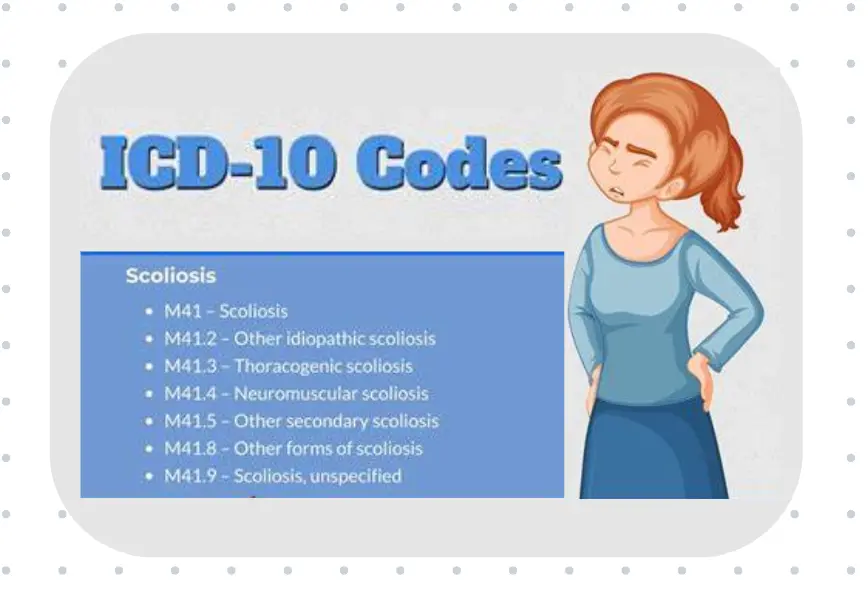Scoliosis is a medical condition characterized by an abnormal curvature of the spine. It affects people of all ages, from infants to adults, and can have a significant impact on their quality of life. In order to accurately diagnose and treat scoliosis, healthcare professionals rely on a standardized coding system known as the International Classification of Diseases (ICD). The ICD code for scoliosis provides a detailed classification of the condition, allowing for accurate documentation and communication among healthcare providers. In this article, we will explore the ICD code for scoliosis and its usage in medical records.

Understanding the ICD Code System
The ICD code system is a globally recognized classification system used to categorize diseases, injuries, and other health conditions. It is maintained by the World Health Organization (WHO) and is regularly updated to reflect advances in medical knowledge and technology. The ICD code for scoliosis falls under the broader category of musculoskeletal disorders and is assigned a specific code based on the type and severity of the condition.
Importance of Accurate Scoliosis Diagnosis
Accurate diagnosis is crucial in the management of scoliosis. It helps healthcare providers determine the appropriate treatment plan and monitor the progression of the condition over time. The ICD code for scoliosis plays a vital role in ensuring accurate diagnosis and documentation. By using the correct code, healthcare providers can communicate effectively with other professionals involved in the patient’s care, such as surgeons, physical therapists, and orthotists.
Overview of Scoliosis ICD Code Classification
The ICD code for scoliosis is classified based on various factors, including the cause of the condition, the age of the patient, and the severity of the curvature. This classification system allows for a more detailed understanding of the condition and helps guide treatment decisions. Let’s explore some of the commonly used ICD codes for scoliosis.

Commonly Used ICD Codes for Scoliosis
1. ICD Code for Idiopathic Scoliosis
Idiopathic scoliosis is the most common type of scoliosis, accounting for approximately 80% of cases. It refers to cases where the cause of the curvature is unknown. The ICD code for idiopathic scoliosis is M41.0.
2. ICD Code for Congenital Scoliosis
Congenital scoliosis is present at birth and is caused by abnormal spinal development during fetal development. The ICD code for congenital scoliosis is Q76.3.
3. ICD Code for Neuromuscular Scoliosis
Neuromuscular scoliosis is associated with underlying neuromuscular conditions such as cerebral palsy, muscular dystrophy, or spinal cord injury. The ICD code for neuromuscular scoliosis is M41.3.
4. ICD Code for Degenerative Scoliosis
Degenerative scoliosis occurs in older adults and is typically caused by age-related changes in the spine, such as degenerative disc disease or osteoarthritis. The ICD code for degenerative scoliosis is M41.4.
5. ICD Code for Adult Scoliosis
Adult scoliosis refers to scoliosis that develops or persists into adulthood. It can be idiopathic or secondary to other conditions. The ICD code for adult scoliosis is M41.5.
6. ICD Code for Adolescent Scoliosis
Adolescent scoliosis is diagnosed during adolescence and is often idiopathic. The ICD code for adolescent scoliosis is M41.2.
Utilizing the Scoliosis ICD Code in Medical Records
The scoliosis ICD code is an essential tool in medical records as it allows for accurate documentation and tracking of the condition. Healthcare providers use the code to record the diagnosis, treatment, and outcomes of scoliosis patients. This information is valuable for research purposes, quality improvement initiatives, and reimbursement purposes.
By consistently using the scoliosis ICD code, healthcare providers can contribute to a comprehensive database of scoliosis cases, which can help improve understanding of the condition and guide future treatment strategies. Additionally, the code facilitates communication between healthcare providers, ensuring that accurate and relevant information is shared among the care team.
In conclusion, the scoliosis ICD code is a vital component of medical records for accurate diagnosis, treatment, and monitoring of scoliosis patients. It provides a standardized classification system that allows for effective communication and documentation among healthcare providers. By understanding and utilizing the scoliosis ICD code, healthcare professionals can contribute to improved patient care and outcomes in the management of scoliosis.
References
- Weinstein SL, Dolan LA, Cheng JC, et al. “Adolescent idiopathic scoliosis.” Lancet. 2008;371(9623):1527-1537. doi: 10.1016/S0140-6736(08)60658-3.
- Negrini S, Donzelli S, Aulisa AG, et al. “2016 SOSORT guidelines: Orthopaedic and rehabilitation treatment of idiopathic scoliosis during growth.” Scoliosis and Spinal Disorders. 2018;13:3. doi: 10.1186/s13013-018-0175-8.
- Trobisch P, Suess O, Schwab F. “Idiopathic scoliosis.” Dtsch Arztebl Int. 2010;107(49):875-883. doi: 10.3238/arztebl.2010.0875.
- Hresko MT. “Clinical practice. Idiopathic scoliosis in adolescents.” N Engl J Med. 2013;368(9):834-841. doi: 10.1056/NEJMcp1209063.
- Bettany-Saltikov J, Weiss HR, Chockalingam N, et al. “Surgical versus non-surgical interventions in people with adolescent idiopathic scoliosis.” Cochrane Database Syst Rev. 2015;2015(4). doi: 10.1002/14651858.CD010663.pub2.
- Social Security Administration. “Disability Benefits.”
- Lonstein JE, Carlson JM. “The prediction of curve progression in untreated idiopathic scoliosis during growth.” J Bone Joint Surg Am. 1984;66(7):1061-1071. doi: 10.2106/00004623-198466070-00008.
- Kaspiris A, Grivas TB, Weiss HR, Turnbull D. “Scoliosis: Review of diagnosis and treatment.” International Journal of Orthopaedics. 2013;37(1):34-42. doi: 10.1038/s41390-020-1047-9.
- Monticone A, Ambrosini A, Rocca B, Ferrante S. “Effects of a multidisciplinary rehabilitation program on spinal deformity and quality of life in adult scoliosis.” Spine J. 2016;16(11):1328-1340. doi: 10.1016/j.spinee.2016.06.014.

